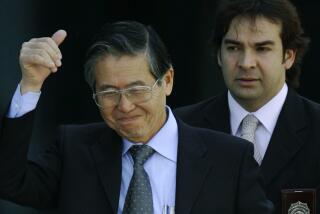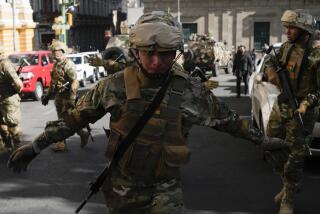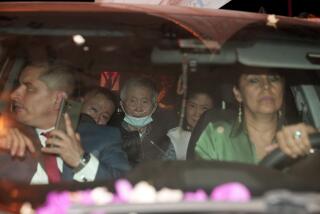Peru Guerrillas Allow Media Inside Mansion
- Share via
LIMA, Peru — The guerrillas of the Tupac Amaru Revolutionary Movement opened a door Tuesday onto the stark, barricaded world of the Japanese diplomatic compound, allowing cameras for the first time into the mansion where they are holding 81 hostages.
As the standoff completed its second week and hopes of a quick resolution before the New Year faded, the polite, fearsomely armed terrorists received a group of photographers beneath the chandelier of a bedraggled living room in which furniture and boxes were piled against windows.
The gripping scene inside the residence of the Japanese ambassador reflected once again the rebels’ talent for putting on a media show with the compliance of a swarm of international journalists. And in another of the hostage releases that have marked the rhythm of the siege, the Tupac Amaru guerrillas set free the ambassador of Honduras and the Argentine consul.
But Tuesday’s developments dashed rising expectations during recent days that negotiations were on the verge of a breakthrough.
In contrast to recent conciliatory words on both sides, rebel leader Nestor Cerpa Cartolini coolly reiterated his demand for the release of hundreds of comrades from Peruvian prisons.
Asserting that Peruvian President Alberto Fujimori continues to be “confrontational,” Cerpa told the journalists: “I don’t see an immediate solution.”
Rocking back and forth on his toes, his tone mild and measured behind a red-and-white face scarf, the clandestine field marshal who led one of the most audacious and sophisticated terrorist attacks in years said the leftist guerrillas have set no deadline.
“There is a crisis in the nation that has been caused by this political-military blow on our part,” the veteran Tupac Amaru leader said. “And it is the government that has to say how to resolve it. We are not in a hurry.”
Fujimori, who has forged a stern image based on his victories against terrorism, sounded somewhat flexible earlier in an interview with a Spanish news service.
Breaking a 10-day silence, Fujimori said he will not release imprisoned Tupac Amaru rebels--a point on which the terrorists appeared willing to give ground in statements over the weekend. But Fujimori indicated that “alternatives” could be considered regarding the fate of the guerrillas who took over the diplomatic compound during a gala reception two weeks ago.
“I believe that in the end, reason will impose a solution without the spilling of blood,” Fujimori said.
He added that he will not rule out a military action against the hostage-takers until they release their hostages and lay down their arms.
Cerpa resumed the duel of words with Fujimori on Tuesday morning in a speech delivered from a second-floor window with a bullhorn.
He warned that, if the president orders an attack, any deaths among the hostages will be Fujimori’s responsibility. Using impassioned cadences reminiscent of a political candidate, Cerpa denounced “terrorism of the state” against the poor. He declared: “We are ready to sacrifice ourselves until the final consequences; we will not back down.”
The performance was vintage Cerpa, according to Hector Jhon, a former high-ranking police official who crossed swords with the guerrilla as chief of Peru’s anti-terrorist police in the early 1990s.
Jhon said Cerpa was trying to further cultivate the Tupac Amaru’s image as “civilized” guerrillas who go out of their way to condemn Peru’s larger and more fanatical terrorist group, Sendero Luminoso, or Shining Path.
Cerpa also showed characteristic sang-froid, said Jhon, who is now a Lima City Council member with Fujimori’s political coalition.
“He has an alarming serenity,” Jhon said in an interview. “It is as if he were just doing another routine job. And he is gambling with the destiny of his organization.”
The news conference with the guerrillas Tuesday was partly impromptu and partly another move in a chess game Cerpa is playing with the government.
The rebel leader has displayed a knack for theatrics that keep the attention of the media.
At the apparent request of the Tupac Amaru, Peruvian police agreed to permit photographers and camera crews among the hundreds of journalists here to approach the residence.
The rules were that the journalists would not enter the compound: They were instructed to cross police lines in groups of 15, take pictures and keep walking.
The first group honored the agreement and recorded Cerpa’s bullhorn speech from the street.
But the second group, led by a Japanese camera operator, veered into the estate and swarmed up to the front door, where Tupac Amaru gunmen frisked them and let them inside.
In an unruly scene, another cameraman broke through police lines, fought off two police commandos who tried to grab him and ran into the compound to join the rest.
Inside the bedraggled mansion, Cerpa held court. He was flanked by youthful and diminutive fighters wearing blue uniforms and girded for combat with flak jackets, machine guns, jungle knives in scabbards and a grenade launcher. Among them were two women, dark black hair spilling from beneath their caps, who looked younger than 20.
The guerrillas said they have trained and lived in the jungle, so they are not bothered by the squalid conditions. The mansion has no power or water and is pervaded by a smell of rotting fruit left over from the ill-fated reception, as well as garbage and human waste, according to the journalists, who spent more than an hour in the Japanese ambassador’s residence.
Showing the deference to the hostages that has been their trademark, the guerrillas brought in Peruvian Foreign Minister Francisco Tudela, Japanese Ambassador Morihisha Aoki and a congress member to address the cameras. The hostages looked calm, but pale and worn down by two weeks in captivity.
Tudela’s public statement last week was seen as a call to the Fujimori administration to accelerate negotiations. He said he has not participated in the negotiations.
“I am not in a position to judge the dialogue, but I do emphasize the necessity of dialogue,” he said.
Afterward, Aoki spoke briefly in Japanese and Spanish.
The tall, silver-haired diplomat managed to look distinguished even though he was wearing a rumpled, loose-fitting shirt. He said the captives are in good health and repeated his apologies for the ordeal that has occurred in his home, showing the sense of hospitality and courage that has awed observers.
“He has carried himself with elegance and dignity,” said Carlos Alberto Yrigoyen, a freed hostage and a former high-ranking Peruvian diplomat to Japan, who spent a week crammed into the ambassador’s bedroom with 40 other VIP captives.
Later in the afternoon, the rebels released the Argentine and Honduran diplomats after a visit by Bishop Juan Luis Cipriani of Ayacucho, who has rare access to President Fujimori’s secretive inner circle.
The bishop is playing an increasingly visible role in the talks with the Tupac Amaru over the fate of the remaining 81 hostages.
More to Read
Sign up for Essential California
The most important California stories and recommendations in your inbox every morning.
You may occasionally receive promotional content from the Los Angeles Times.










